Prishtina Insight spent three days traversing southern Kosovo with a simple mission: to find interesting people and places, and to tell their stories.
Benzinska Pumpa Bengazi, in the village of Recan, sits along a winding road in the Sharr Mountains, between Kosovo’s version of Aspen, Prevalla, and the city of Prizren.
Benghazi Gas Station, as it translates from Bosnian, is conveniently located near the Marlboro Family Restaurant — its sign in the style of the cigarette brand — and The White House, which offers all kinds of meaty fare in a miniature version of the home of the American presidency. I’d driven this road more than a few times in my five years in Kosovo, and had a chuckle at the restaurants and their outsized love for America. But I only noticed Bengazi recently while driving with Atdhe Mulla, a photographer from Prishtina. Atdhe thought the owner might have worked in Libya, as thousands of Yugoslavs did. I wondered if the inspiration was more contemporary, perhaps a nod to Benghazi’s important role in the fall the Libyan dictator Muammar Gaddafi during the Arab Spring. As it happened, we were both wrong.
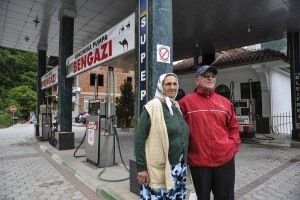
Zemalija and Bajram Huduti. Photo: Atdhe Mulla.
Bengazi beckons drivers with a sign depicting a desert scene with two camels and an oil pump. We found the owner, Bajram Huduti, 75, inside the office, where flags of Kosovo, Bosnia and Herzegovina, and Turkey were posted – but nothing Libyan.
“It’s a play on words – a combination of ‘ben’, for benzine and ‘gazi’, for autogas,” explained Huduti, who has owned Bengazi with his wife, Zemalija, 70, for 23 years. The connection to Libya was about the country’s status as a major oil producer. As we talked to Bajram, wearing a red windbreaker and baseball hat, Zemalija, in a handwoven wool sweater and a headscarf, cheerfully tended to a customer and pumped his gas.
Growing up in the liberal bastion of Berkeley, California, I’ve been programmed to actively resist any kind of stereotyping, but I found it astonishing to see someone who looked like a grandmother from a previous century doing something that in Kosovo, at least, and probably much of the world, is reserved for men under 50. “We’re Bosniaks. We’re not like Albanians. The men do less work than the women,” Bajram said, as Zemalija walked over, nodding in agreement.
The brief encounter with the Hudutis was a fitting start to a journey across southern Kosovo. I spent three days in Prizren, Malisheva, Rahovec, Suhareka, Mamusha and Dragash to begin a five-part series that will ultimately cover all 38 municipalities in Kosovo. Something I found, and suspect we’ll continue to find, is that Kosovo has a way of confirming and defying expectations, for better and for worse.
Kosovo covers an area of around 10,900 square kilometers, putting it on similar footing as Jamaica and Lebanon. It’s a small country but one that is best experienced slowly.With the exception of the Ibrahim Rugova Highway to Albania and a couple of other roads, it’s difficult to exceed 60 kilometers per hour for an extended period of time unless you have a deathwish. The roads are narrow, often winding, and, despite massive investment in road building, holes and bumps and other abrupt changes tend to appear often and suddenly.
Kosovo is a small country, but one that is best experienced slowly.
While I’ve gotten used to the frenetic style of driving, I continue to subject my 1999 Volkswagen Golf to violent encounters with the road itself because I learned to drive being told to look about 10 seconds ahead. It makes it easy to spot people, cars and other large obstacles sufficiently far in advance to take action. But it’s easy to miss a pothole. I’ve tried to explain that to passengers born in Kosovo, including my fiancee, but no one seems to believe me. I’m sure they think it’s just lousy driving.
Dragash
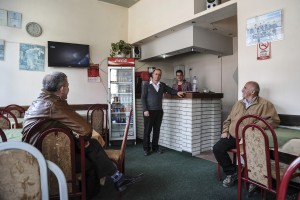
Kafiteri Berati. Photo: Atdhe Mulla.
In Kosovo, where it’s better to measure distances in time rather than kilometers, Dragash is especially far away. The municipality encompasses Kosovo’s southern tip, like a short tree trunk surrounded by Albania, Macedonia and the rest of the country, covered in mountains. It took us nearly two hours to drive the 35 kilometers from Prizren to Dragash town, snaking our way up the mountains. I’d never been to Dragash before but knew its reputation as one of the country’s natural gems and had long enjoyed its famous cheese. A UN employee wrote an entire book about hiking in the area. But the reality of Dragash is that it’s an isolated, economically underdeveloped pocket of an isolated, economically developed country.
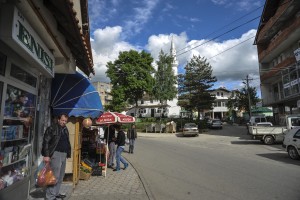
Downtown Dragash. Photo: Atdhe Mulla.
“We have the nature, good meat, Sharri cheese and old tradition,” Blerim Hamdiu, the owner of Kafiteri Berati told me. “But we don’t have any jobs.”
Berati, in the center of Dragash, is one of those older-timer cafes that you see less and less of in Kosovo, where carbonated water is served with the coffee and most customers are over 50. The decor is minimal and includes a portrait of Kosovo Liberation Army fighters who died in the area.
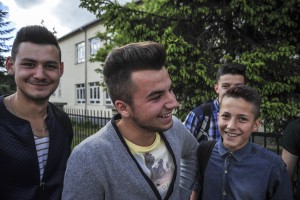
Dragash youngsters. Photo: Atdhe Mulla.
As photographer Atdhe Mulla and I sipped our 40-cent coffees outside, throngs of teenagers seemed to be drawn to the euro pop coming from Meka, large complex with a supermarket, hotel and halal restaurant across the street. The youngsters looked like they could have been from anywhere in Kosovo, except for the boys who all seemed to be sporting Duck’s Ass haircuts straight out of the 1950s. “Why do you guys all have the same haircut?” Atdhe asked a group who asked him to take their picture. They explained that it was because the town had only one barber.
Brod
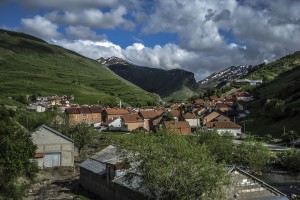
The rolling hills of Brod. Photo: Atdhe Mulla.
As the late afternoon sunlight began to fade, we made our way to the village of Brod in another slow drive that covered 10 kilometers in 30 minutes. Surrounded by brilliant green hills and mountains still snowcapped in May, Brod represents a collision of centuries and people. It seems to be the last stop before civilisation ends and nature takes over. Herds of sheep and men on pack mules coexist with satellite dishes and a 90-euro-per-night hotel.
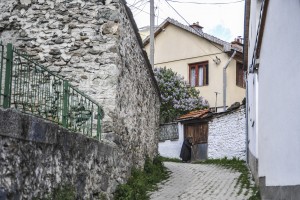
Brod. Photo: Atdhe Mulla.
It’s a place where Albanians mix with a large population of Bosniaks and Gorani, who are difficult to distinguish culturally, linguistically and religiously — they are Muslims who speak the same South Slavic language — but are divided politically. We left our car near the river and made our way past the post office, where a horse was grazing in the front yard, to the Sar Cajdzinica, the teahouse.
Surrounded by brilliant green hills and mountains still snowcapped in May, Brod represents a collision of centuries and people.
The dark wooden building looked as if was more than a century old, while a few modern touches were inside: a TV tuned to RTS, the Serbian state broadcaster, and a few old calendars – two of Peja beer featuring women in bikinis and another depicting a mosque in Turkey.
Two older men drank juice in one corner, while two young boys ate sunflower seeds and eagerly tested out their English. Ramadan Sar, the 55-year-old owner, has lived in Brod his entire life. For 40 of those years he has served tea, often working 15 hours a day, every day, sometimes earning around three euros: “It’s just enough to survive.” Hundreds of families have left the area during his lifetime. Those who remain largely do so because relatives living abroad support them.
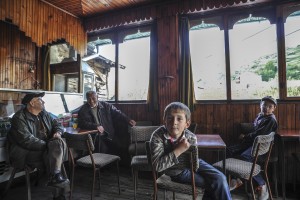
Sar Cajdzinica teahouse. Photo: Atdhe Mulla.
“If it wasn’t for remittances, this village would disappear,” Sar said in Bosnian, after serving us double glasses of black tea with nearly enough syrup to give it the consistency of light syrup. While Brod gets its share of visitors, Sar lamented that most people miss his teahouse entirely and its 10-cent glasses of tea as they make their way to the 90-euro-per-night hotel on another road.
Malisheva
Two days later, Atdhe and I were making good time, on track to make a morning appointment with Arif Butuc, the Mayor of Mamusha, the only Turkish-majority municipality in Kosovo. But the traffic came to a dead halt near the town of Komoran. Protesters backed up by two full-sized trucks straddled across all four lanes of the Prishtina-Peja highway were protesting over the previous day’s conviction of former KLA leaders for war crimes including the Mayor of nearby Skenderaj, Sami Lushtaku. They left after about an hour. With our meeting with Butuc pushed back to the afternoon, we instead went to Malisheva, another municipality with strong ties to a former KLA commander turned politician, Fatmir Limaj, leader of the opposition party, NISMA.
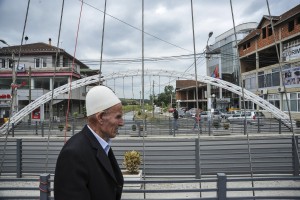
A man sporting a plis, the traditional Albanian woolen hat. Photo: Atdhe Mulla.
Limaj, the former transport minister and perhaps Kosovo’s most prolific roadbuilder, is from Malisheva. Having never spent much time in the municipality, I assumed that the roads would be especially good. I was wrong.
Limaj, the former transport minister and perhaps Kosovo’s most prolific roadbuilder, is from Malisheva. Having never spent much time in the municipality, I assumed that the roads would be especially good. I was wrong. In Orlat, not far from Malisheva proper, the road effectively had broken in two, as if someone has twisted it with both hands. The trouble with Limaj’s time as minister was that millions of euros in road tenders were awarded to friends and family, including people with no relevant experience in the field, something this newspaper revealed in 2010. An investigation by the EU’s rule of law mission followed, as did charges of corruption and misuse of authority. Limaj has denied wrongdoing, and the case remains in the courts. He also continues to face war-crime charges, despite two acquittals.
The town center forms around a tidy park with a fountain and a memorial to Adem Jashari, the KLA commander who died along with some 60 family members in a siege with Serbian security forces in 1998. However, I was determined to learn other things about Malisheva. While looking for the entrance to the museum, which was closed that day, we stumbled on the public library.
Not surprisingly, the librarian, Lumturije Bytyqi, reads a lot. A fan of mysteries, she had just finished an Albanian translation of “The Ice Princess” by Swedish author Camilla Lackberg when we arrived, one of about 7,000 titles in the library. “She’s a bit like Agatha Christie,” Bytyqi explained. Born in Mitrovica, Bytyqi moved to Malisheva as a child and has no plans to leave. “Mitrovica is a bigger city. I like that Malisheva is a calm, small town with a nice park,” she said.
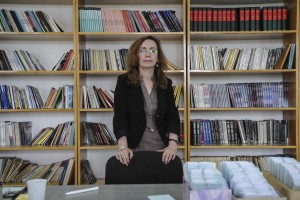
Malisheva’s librarian, Lumturije Bytyqi. Photo: Atdhe Mulla.
Most visitors to the single-room library are students. As I talked with Bytyqi, Ardit and Fortesa Hoti walked in. Fortesa, 17, wearing a green camouflage jacket, was returning a copy of Ismail Kadare’s “The Castle,” an historical novel about Albanian resistance to the Ottomans in the 15th century. Fortesa told me she checks out a new book every two weeks (Bytyqi confirmed this and said Fortesa always returns books on time.) “My dream is one day to become an English professor,” she told me. I asked Ardit, 18, who was wearing a large gold chain and a Harlem Shake T-shirt about the last thing he had read. “It was on Facebook,” he joked. Ardit is studying construction engineering in Gjilan and plans to join the family construction business.
We left the library, making our way past a gaggle of teenage girls assembled on the stairs. I felt bad for feeling surprised about encountering Fortesa returning the Kadare book. It is easy to forget, with all of Kosovo’s problems, particularly with the troubled state of the education system, from preschool to the university level, that a curious 17-year-old can do a lot from simply having access to books.
Mamusha
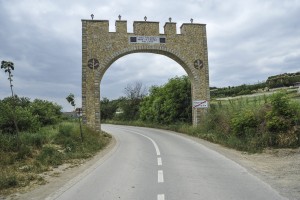
Entering Mamusha. Photo: Atdhe Mulla.
Mamusha, a municipality established only in 2008, feels like it is making up for lost time. A large gate covered in cobblestones with a small sign welcoming visitors first in Turkish (Hos Geldiniz), followed by Albanian and English, it is one of the hallmarks of the only mayor that Mamusha has ever known, Arif Butuc. A former journalist, he has presided over the development of a local tomato industry that has its own festival. (It’s on July 23). “These tomatoes are not for ketchup, they’re for the table. Eating one is like kissing a beautiful woman,” Butuc said, sitting on a leather sofa in his office.
Around 5,500 people in the only mainly Turkish municipality in Kosovo. The community traces its linage back to the five centuries Ottoman rule in Kosovo, and Butuc has helped cultivate close ties with Turkey, which has provided millions of euros in investment though Turkish Cooperation and Coordination Agency, TIKA, and stationed some KFOR peacekeepers there.
In 2013, amid anti-government protest in Turkey, locals from Mamusha including Butuc rallied in support of Recep Erdogan who was then the Prime Minister. Erdogan visited Mamusha in 2010, and Butuc prominently displays a picture of the two men together in his office. “It was a pleasure having him here,” he recalled.
Interested as I was to hear about Turkey’s support for Mamusha, I wanted to know more about the tomatoes, specifically where I could actually sample them.
Interested as I was to hear about Turkey’s support for Mamusha, I wanted to know more about the tomatoes, specifically where I could actually sample them. Before the meeting, a walk along the entire length of Domates (Tomatoes) Street did not yield a single tomato. Unfortunately, Butuc explained, it was not tomato season yet. But he suggested that we return as his VIPs at the upcoming Tomato Festival. Before leaving he presented me and my colleague, Valerie Hopkins, with copies of the municipal promotional booklet, which he held up, insisting that we pose for pictures with him. The book, unfortunately, has a section on handcrafts translated in English as “Hand Jobs,” accompanying a picture of a girl in a traditional dress.
Butuc’s finance director, Skender Sala, escorted us for the rest of the afternoon in town. Sala, while not especially talkative, took us to lunch at Genc Osman Kofteci, a smoke-filled restaurant that seemed on one level like all the other qebaptores in Kosovo.
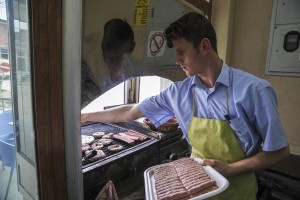
Qebapa at Genc Osman Kofteci. Photo: Atdhe Mulla.
But as Sala explained, everything apart from the tomatoes — because they weren’t in season — was from Mamusha, including the meat. The cabbage, cucumbers and peppers may have been the best vegetables I’ve eaten in Kosovo, a universe away from the often bitter, acrid produce that often gets served in Prishtina. Notably absent from the restaurant or the rest of the town were women. Sala said they were all at home.
After lunch, Butuc directed us up a direct road to a farm, where a black Mercedes soon pulled up from which the farmer, Fatih Mazrek, emerged, a Lacoste shirt tucked into his jeans. He walked us into his tomato farm shielded in a plastic greenhouse.
The smell was overpowering but the tomatoes were still green, weeks away from ripening. The tomatoes alone can earn his family 50,000 euros per year in profit. “But it can just was easily go to negative 50,000,” he noted. Business would be a lot better if he could export his tomatoes to the EU, he said.
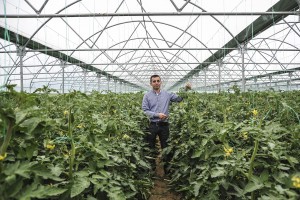
Mamusha tomatoes. Photo: Atdhe Mulla.
We left Mamusha with a half-dozen cucumbers from Mazrek’s farm, with blossoms still on the ends. A few days later, I made them into a simple salad with olive oil and lemon juice. They were nothing short of spectacular.
Rahovec
Whenever I’m asked to recommend a Kosovo wine, I usually suggest Sefa. This isn’t just because the wine is good – it’s also a wine that I want to like. Blerim and Labinot Shulina, 33 and 34, respectively, have only been in the wine business since 2011, and they seem to have embraced the idea that good Kosovo wine should be unique.
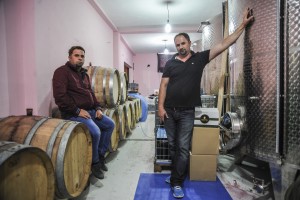
Blerim and Labinot Shulina at their vineyard. Photo: Atdhe Mulla.
When I first visited their tiny cellar in Rahovec about a year ago, Labinot, who does the winemaking, was still using plastic tanks. Even then, the chardonnay had the aroma of honeysuckle growing in the nearby vineyards. It was the first time I truly understood that terroir was a real thing and just not an oenophile’s fantasy.
When I returned in May, dramatic changes were afoot. Stainless steel tanks had replaced the plastic ones, and already the wine had shown a dramatic improvement. Labinot’s vranac, a red grape native to the Balkans, was bolder and more vivid. “It has an Albanian character, like a strong black horse,” Labinot said. In the oak barrels that Labinot ages some of the wines in, the vranac was mellowing out. But what really impressed was the pinot noir, a notoriously fickle and delicate grape that rarely tastes like it’s supposed to in Kosovo. But, Labinot’s latest vintage, from 2012, was fruity and nuanced, with lip-smacking tartness.
While it’s not ready to do battle in California, it’s still a damned fine wine. Labinot’s next challenge is experimenting with blends.
Sefa produces about 60,000 liters of wine per year, according to Blerim, who manages the business. All of it is sold in Kosovo, but Blerim is looking to export, initially in Albania. “In 10 years, I’m hoping to grow the business 100 per cent,” Blerim said, outlining his ambitious but attainable goal. His only complaint is that the government doesn’t do more to promote Kosovo wine. The Shulina brothers are preparing to release a new premium wine called Kulla Sefa, referring to the Albanian equivalent of a chateau. They expect to sell it for at least 10 euros a bottle. It is expensive for Kosovo, but the sip of cabernet I tried seemed worth it. They wouldn’t let me take a bottle, so I settled for a bottle of pinot and bottle of vranac, which I bought for five euros.
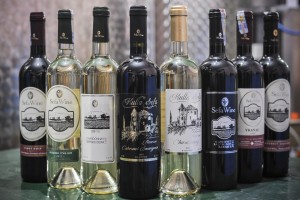
Sefa varieties. Photo: Atdhe Mulla.
Velika Hoca
Just outside the town of Rahovec, home to most of Kosovo’s winemakers, the tiny hamlet of Velika Hoca serves as the capital for Serbian producers. It was almost 7pm as I approached from the single narrow road leading in. Most of the town seemed closed up for the day, but the Petrovic winery still was open. Inside, amid the barrels and stainless steel tanks, two old men were sipping cans of Montenegrin Niksicko beer. “Wine is for winter,” one the men said, when I asked why they weren’t drinking wine. They were minding the store for Srdjan Petrovic, the owner.
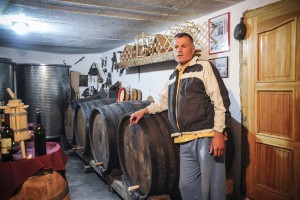
Petrovic winery. Photo: Atdhe Mulla.
Petrovic quickly poured Atdhe and I glasses of his Metohijsko red wine, a robust blend of vranac and several other varieties, that was clearly high in alcohol. Petrovic explained that the family had been making wine since the 18th century, and even had a land deed on display dating back to the Ottoman Empire. His great-grandfather left for the United States in 1896 and, according to family lore, returned eight years later with gold stitched into his clothing, newfound wealth that he invested in a winery.
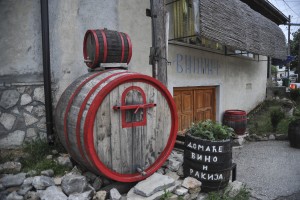
Petrovic winery. Photo: Atdhe Mulla.
“The Communist years in Yugoslavia were the hardest. The agricultural reforms created a lot of trauma for the wine industry,” he said, explaining that many vineyards were destroyed. The wine business has been recovering, he said, but modestly. He largely sells to visitors to the winery, including those who stay at the hostel above the cellar and some restaurants, including a few in Prishtina. On our way out, laden with bottles of wine, we encountered around 20 Serbian students who were spending the night there, no doubt with copious amounts of wine and rakija.
Prizren
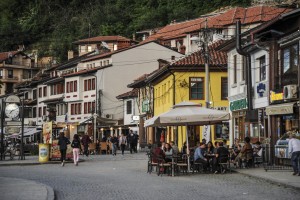
Cafes in downtown Prizren. Photo: Atdhe Mulla.
I saved Prizren for the last stop on my tour of southern Kosovo, in part because it is more of a known quantity. It’s one of the few cities in Kosovo that still has real claim to splendor with all its preserved Ottoman-era heritage, not to mention the Dokufest International Film festival held every summer. Part of its charm is that the heart of the city always seems to stay the same.
To Ares Shporta, 23, a native, life in Prizren can be Kafkaesque for that reason, particularly during the colder months. “It’s a consistently depressing place, which I kind of like sometimes,” Shporta said, with a laugh as we sat at a teahouse in the old town. To Shporta, the old-world charm that visitors relish when they come is a kind of prison for young people, particularly because the city tends to be socially conservative. It is the sort of place where it’s hard to get a drink during Ramadan.
Prizren is one of the few cities in Kosovo that still has real claim to splendor with all its preserved Ottoman-era heritage.
With the old cinema, Shporta is hoping to foster a haven for young people to create and innovate and be themselves. For years, the 60-year-old Kino Lumbardhi languished as a former state-owned enterprise that was due to be privatised. But, following a grassroots campaign led by Dokufest, the privatisation process has been halted. Shporta is overseeing its revival as a year-round cultural center, called Lumbardhi.
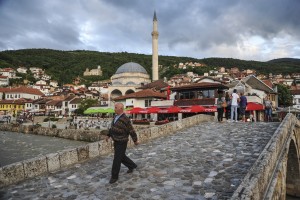
The Sinan Pasha Mosque pokes out of the Prizren landscape. Photo: Atdhe Mulla.
While the outside has been used for film screenings, the inside looks like it hasn’t been touched in decades. There are even stacks of unused tickets from the Yugoslav times, old film reels, and a cobwebbed indoor cinema. Growing up in the 1990s, Shporta remembers it being used as a porn theatre. “It wasn’t a place to which mothers and fathers wanted to take their kids,” he said. Lumbardhi officially opened with an installation from the performance art group Angry Youth in late May, which 600 people attended. However, much work remains to be done. Lumbardhi still has a problem of a power bill for 11,000 euro. For the time being, it connects to a neighbor’s power line. When everything is up and running, Shporta foresees Lumbardhi not just as a place for exhibitions and screenings but for people to drop by and be themselves, whether to have coffee or engage in a more creative endeavor. In broader terms, he sees an important link between Prizren’s past and future.
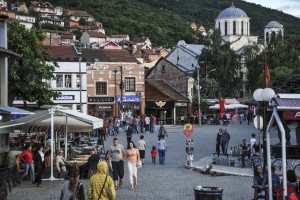
The bustling historic center. Photo: Atdhe Mulla.
“Prizren has beautiful stories that remain untold and are vanishing,” he said. “We are supplying the city with something it needs but doesn’t know it needs, and one day this will become a cultural embassy.”
After a dinner of qofte and qebapa by the river and some baklava in town, we meandered our way home, not along the nearly 1 billion euro highway but along the old road that runs through Suhareka. After passing an endless series of wedding halls, love motels and gas stations, we headed into the hills, toward the Sharri mountains, into a part of the country I’d never been to. There were stunning vistas overlooking the rich vineyards below, and big houses and KLA memorials along the road. We stopped for coffee in the village of Budakova at a restaurant called Diana, done up in elegant dark wood. In another hour or so we’d be back in Prishtina.
*This article was initially published in 2015 in the June 5-18 print issue of Prishtina Insight. To browse seven years of Prishtina Insight online, click here to become a subscriber.





